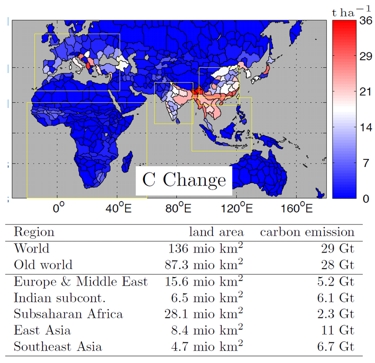|
Global Land Use and technological Evolution Simulations to Quantify Interactions between preindustrial Cultures and Climate
Principal Investigators: Klaus Fraedrich (University of Hamburg), Kai Wirtz (GKSS Geesthacht), Richard Blender (University of Hamburg)
Project Scientists: Carsten Lemmen (GKSS Geesthacht), Kerstin Haberkorn (University of Hamburg)
Holocene regional carbon emission by land use change (deforestation and associated soil loss) up to the year 2000 BC. A summary for different world regions (yellow boxes) and global totals is provided in the adjacent table.
To understand the two-way interaction between past societies and Holocene climate defines a transdisciplinary research challenge. How much did climatic (in)stabilities determine where and when agriculture appeared or cultures disappeared? When did humans start to interfere with the carbon cycle? We formulate a testable framework for human-climate interaction with the model of cultural development and technological adaptation (GLUES) and the Planet Simulator climate model; palaeovegetation reconstructions from proxies are integrated into GLUES to enhance its accuracy and realism. Our study is global with two foci on Western Eurasia and China, and covers the period 11600 to 3000 years BP. By comparing palaeovegetation and archaeological data with coupled model results, we test how reliable cultural development and (adaptive) response can be integrated into the Earth system model. Our results will identify mutual feedbacks between humans and climate. Our framework promotes hypothesis testing in the archaeological sciences and quanties land use changes and emissions required for future Earth system model studies.
Our research is targeted at four overarching goals: (1) To develop a documented coupled simulation software for hypothesis testing and data integration; (2) to assess the sensitivities between cultural adaptation, climate change, and land use change; (3) To quantify methane emissions from rice agriculture; and (4) to produce a global data-set for deforestation and associated carbon dioxide release during Holocene with high spatial and temporal resolution. We directly address the priority program's fourth key question "Which linkages exist between climate and preindustrial cultures?" We assess the postulated link between the demise of prehistorical societies and climate change and test the controversial hypothesis, according to which humans started to influence climate
already during the middle Holocene. Like in phase I, we emphasize the socio-political relevance of our work: we envision to fully integrate the dynamic anthroposphere into today's state-of-the-art earth system models. This is a prerequisite to better understand current human-climate interaction and adaptation to ongoing climate change, as it is observed to take place in physical and ecological systems. Anticipated users of our work are palaeoclimate/paleovegetationmodellers, palaeoclimate variability analysts, archaeologists, agricultural economists and university students.
Time-series analysis, cluster analysis, coupled climate modelling, dynamic vegetation modelling, aggregate system modelling.
Archives
Archive of long-term, high-resolution climate proxies, Neolithic site databases, radiocarbon database.
|
| < Prev | Next > |
|---|


